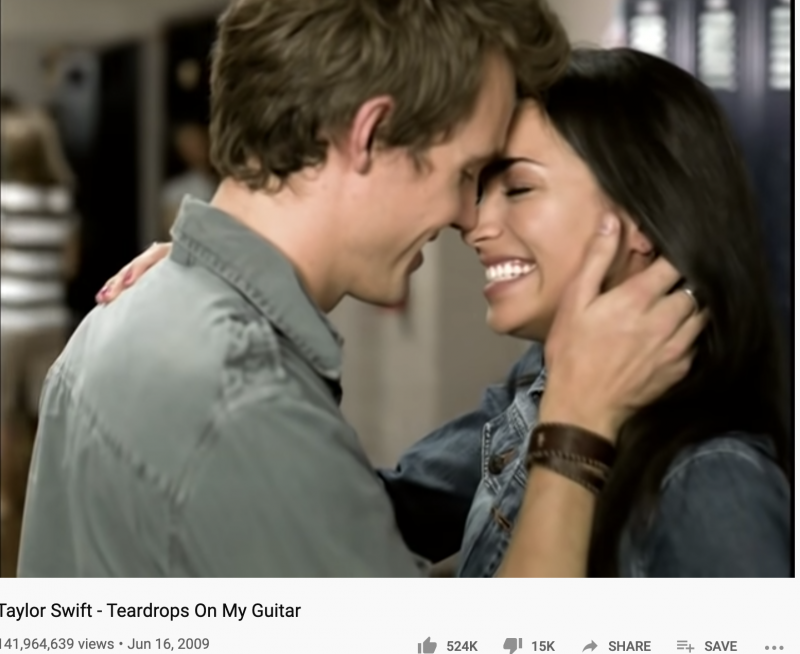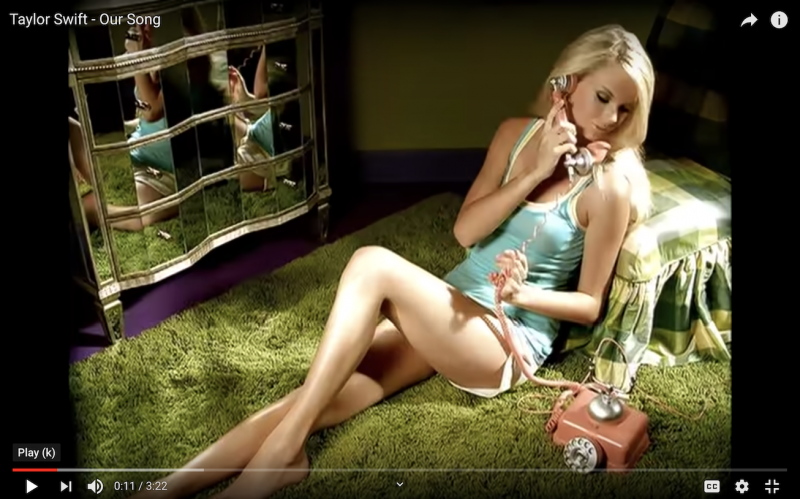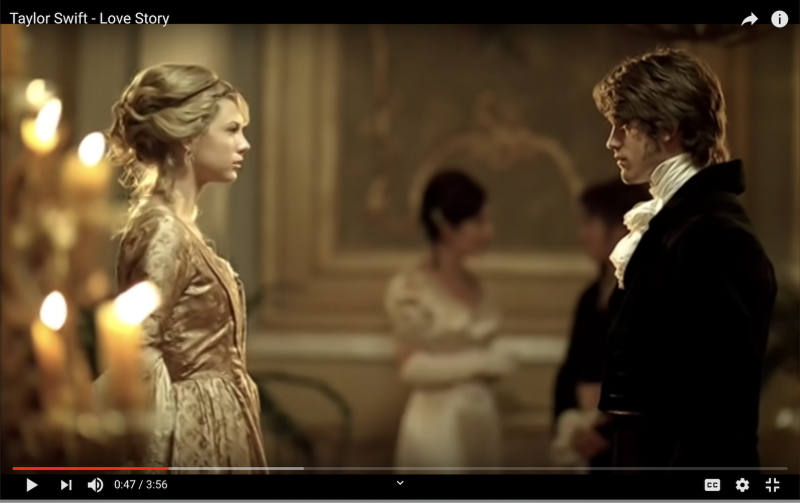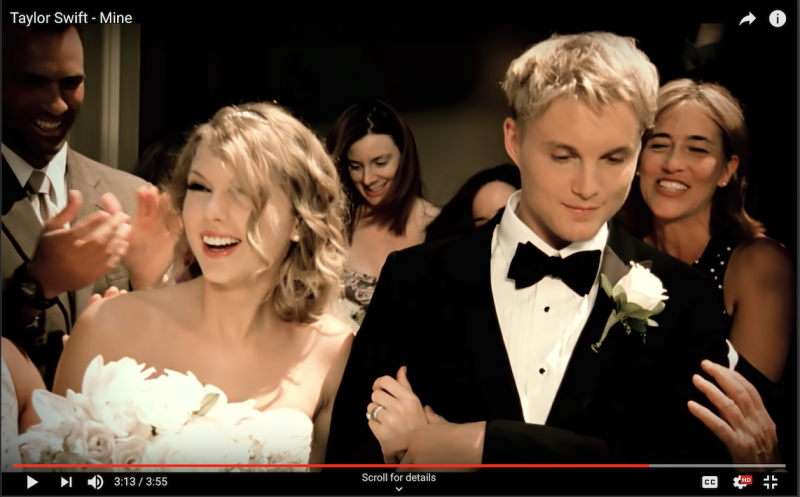On Taylor Swift, Whiteness, and Symbolic Violence
Posted on October 18, 2019First, a personal short story…
The first time I heard Taylor Swift was the beginning of the school year in 2007. I was turning the dial on the radio, when I heard, “Drew looks, at me / I fake a smile, so he won’t see / that I want, and I need him / Everything that we should be” soothingly ringing in the background. I soaked it in. That night, I stayed up way past my bedtime memorizing the lyrics to “Teardrops on my Guitar,” replacing the name to Dan in the lyrics. Never mind that Dan was Chinese-American, and Drew was depicted as a brown-haired, green-eyed beauty (image below). It all paid off when a few weeks later, some blonde girls, armed with hot pink iPod nanos, were all singing the same song in the hallway together, and I could proudly pipe in a few words.
Over time, this obsession slowly expanded. “Our song is the slammin’ screen door / Sneakin’ out late tappin’ on your window…And it’s late and your momma don’t know,” she would coo in a country twang. I spent hours memorizing the accent, Googling all the words that were new to me. Countless songs became stored in the “useless-but-memorized” section of my brain. “She’s so relatable,” I’d tell my friends.
Hours and hours I spent studying the image, life, and lyrics of this blonde-haired, blue-eyed beautiful woman, singing about equally beautiful white boys, being driven around “shotgun” (a term I most definitely had to Google), being saved or let down by “princes” on white horses. This must be what it means to be American, I thought to myself. I inserted myself in her situation, imagining what it must be like to look like that, to admire boys who looked like the ones she described, to be admired by boys who looked like Hollister advertisements, to dream of a nuclear family living in picket white fences.
So why wasn’t my life happening how she described it? I didn’t know; thus began the mission to be transform myself. To be seen as a respectable equal to my peers. Not someone who was different, but someone who could be admired. I desperately wanted to be desired and respected, and I didn’t care what I had to do to get there. And everyone around me was white.
Eventually, I started to notice a pattern. In the people I was attracted to, the people I admired, in the people that became or that I wanted to become friends with. Over time, while the people changed, a lot stayed the same: the white ideals, all the times where I erased myself and my various identities, to make myself smaller and adopt “white” behaviors and values that I first learned, modeled in Taylor’s songs. In her music, I saw the future “me” – a different “me.” I studied her, hoping one day to be seen as an equal – an “American” – a white American.
Along with it came embarrassment of my immigrant family, silencing myself in professional settings, erasing myself and making myself small. Afraid to bring up conflict, silencing myself meant in order to adhere to my own standards of a minority behaving amongst whiteness. But I was okay with that.
These thoughts are still ones that I grapple with today.

[A] A still from the Teardrops on my Guitar music video. “Drew” kissing the woman Swift is jealous of.

[B] A still from Our Song, in which Taylor is in the process of painting her toenails and calling her friends on a pink phone, describing how her boyfriend doesn’t need a “song” because their story is enough of a “song.”
Design as symbolic violence: What does that mean?
As mentioned by Boehnert and Onafuwa, symbolic violence is defined by how “priorities, values, and even sensibilities are reproduced through cultural practices, processes and institutions. Through symbolic violence, individuals learn to consider unjust conditions as natural and even come to value customs and ideas that are oppressive” [1]. Through examples such as the AI technology used in computers having trouble distinguishing darker skin tones, and the disproportionate hiring of male designers compared to the majority of design students being female, Boehnert and Onafuwa illustrate the racism, sexism, classicism, and ecoism, in “Design as Symbolic Violence: Reproducing the “isms” + A Framework for Allies” to highlight how various aspects of design, across the process, industry, and consequences, can have implications of symbolic violence [2]. They argue that, given the context of highly political and social relevance to design, designers have a responsibility to play a role in changing and intervening in these narratives, and should “resist the false narratives of design practice without politics” [3].
So, why should I care?
I share my personal experience not to arouse pity, but to share the impact that just one person’s symbolic violence has had on my life, how deep-seated it can be, and how hidden or benign it may seem at first. The messages that Taylor Swift’s music conveyed in popular culture are explicit examples of her work as symbolic violence. Using the lens that Boehnert and Onafuwa use to analyze symbolic violence in design, (understanding symbolic violence through racism, sexism, and classicm, and ecoism – though ecoism is less directly relevant in her work) [1], we can easily understand that Swift is a problematic character, illustrating white ideals and elevating unrealistic and potentially damaging gender roles in her music, performances, and persona. However, growing up listening to her music fed my raw and yet-to-shape brain strong, rigid messages about gender stereotypes, dynamics in relationships, and consequently, whiteness.
The pure act of her being famous, and being such a prevalent part of my life, meant that I embraced the image she conveyed and the messages she shared. In exposing myself to her music, I transformed myself in ways that I didn’t even realize. It was like she had been sneakily sending me clues about how to act, arming me with the images, the words, and tools to behave. As a woman of color who grew up in a predominantly white state that privileged non-immigrant culture, Taylor Swift was one way (arguably the most effective way) that I could connect with my classmates, and I liked it that way. I treated her like a case study to understand and master what it meant to fit in with my peers.
Taylor Swift’s persona and career is a modern-day and pop culture example in my own life, of how design can cause symbolic violence, and how powerful that can be. If I’m only one person, I can only begin to imagine the impact one celebrity may have on whole generations of people still growing into themselves. For me, Taylor Swift is a prime example of how celebrity and fame can serve as unintended and unpredictable forces of design.
Designing for different populations requires deep understandings of how a variety of media and messaging, both implicitly and explicitly, may shape the way we view the world, especially amongst dominantly accepted narratives – whether they be about race, gender, sexuality, class, or anything else. As designers, that means we also need to be able to identify and understand power dynamics in general, but especially amongst these narratives that continually shape our day-to-day lives: on the television, while we shop in malls, in store windows. How can we assess and portray the impact that media and messaging have on various populations? How can we take stances to acknowledge the importance, while shifting these narratives towards different power dynamics in design? How do we begin to break apart these deep-rooted influences while understanding their role in design?

[C] Video still taken from Love Story, in which Swift is dressed in a luxury ballgown, replaying the tragedy of Romeo and Juliet as a fairytale

[D] Video still taken from Mine music video, in which Swift meets a waiter and they end up getting married and having children.
References:
[1] Boehnert, Joanna, and Dimeji Onafuwu. “Design as Symbolic Violence: Reproducing the ‘Ism’s A Framework for Allies.” Intersectional Perspectives on Design, Politics and Power, 14 Nov. 2016. pp 3.
[2] Boehnert, Joanna, and Dimeji Onafuwu. “Design as Symbolic Violence: Reproducing the ‘Ism’s A Framework for Allies.” Intersectional Perspectives on Design, Politics and Power, 14 Nov. 2016. pp 3-6.
[3] Boehnert, Joanna, and Dimeji Onafuwu. “Design as Symbolic Violence: Reproducing the ‘Ism’s A Framework for Allies.” Intersectional Perspectives on Design, Politics and Power, 14 Nov. 2016. pp 10.
Image references:
[A] “Teardrops on My Guitar.” Big Machine Records, LLC, 2007, https://www.youtube.com/watch?v=xKCek6_dB0M.
[B] “Our Song.” Big Machine Records, LLC, 2007, https://www.youtube.com/watch?v=Jb2stN7kH28.
[C] “Love Story.” Big Machine Records, LLC, 2009, https://www.youtube.com/watch?v=8xg3vE8Ie_E
[D] “Mine.” Big Machine Records, LLC, 2010, https://www.youtube.com/watch?v=XPBwXKgDTdE